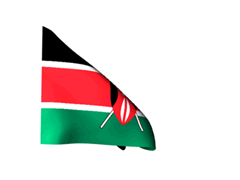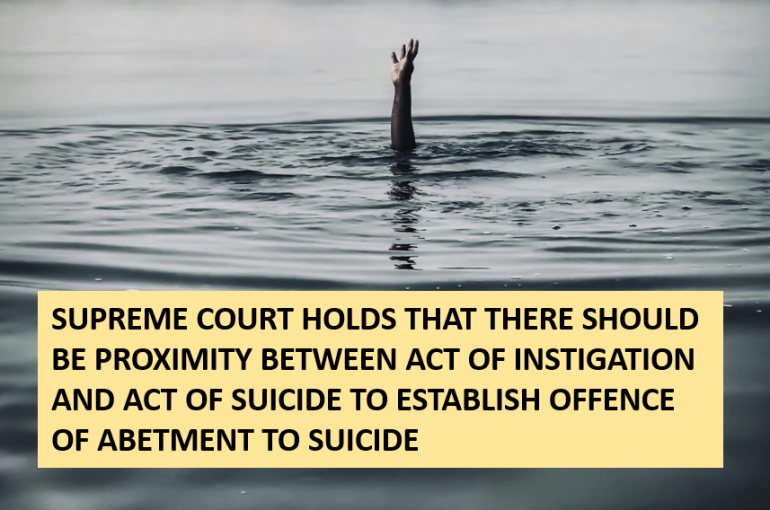SUPREME COURT HOLDS THAT THERE SHOULD BE PROXIMITY BETWEEN ACT OF INSTIGATION AND ACT OF SUICIDE TO ESTABLISH OFFENCE OF ABETMENT TO SUICIDE
A two-Judge Bench of the Hon’ble Supreme Court comprising of Justice B.R Gavai and Justice K. Vishwanathan ruled in favour of the Appellant by setting aside the decisions passed by the lower courts in the matter of Prakash and Others v. State of Maharashtra and Another (Arising out of SLP (Crl.) No.1073 of 2023) on 20th December 2024 . It was observed by the Bench that there must be a close time gap between the alleged incidents of instigation by the accused and the suicide by the victim in Order to establish a nexus between the act of incitement and the act of suicide.
FACTS
One Jyoti Nagre (Deceased) was married to Prakash Panduram Nagre (the Appellant No.1) and was said to have committed suicide by hanging herself to the iron pipe situated in the bathroom of her paternal house according to the Accidental Death Report received by the Police Station, Ashvi District, Ahmednagar on 20th March 2015.
Subsequent allegations were raised by the Deceased’s Mother (Respondent No.2) in a complaint before the abovementioned police station that she was mentally and physically abused by Appellant No.1 and her in-laws. The disputes were later resolved on the intervention of the complainant and their other family members which led the Deceased to continue living at her matrimonial house. However, the continuing hostility received from her matrimonial house led the Deceased and Appellant No.1 to live in a separate house in Lonikand, Pune.
Further allegations were raised by the Deceased that she was physically abused by Appellant No.1 over a demand of Rs.20 lakhs for purchasing a new plot of land which led her to move back to her paternal house. Later, a criminal case Criminal M.A. No.175 of 2013 was filed before the Court of Judicial Magistrate, First Class at Sangamner against the husband and her in-laws under Section 12 (Application to Magistrate), Section 18 (Protection Orders), Section 20 (Monetary Reliefs) and Section 22 (Compensation Orders) of the Domestic Violence Act, 2005.
While the criminal case was pending before the Judicial Magistrate, a Mahalokadalat (forum for disputes pending before the Court at a pre-litigation stage) was formed at the Court in Sangamner on 17th February 2015. The Deceased’s Mother (Respondent No.2) raised allegations that the Appellants in this present matter refused to reach a settlement and claimed that the Deceased would not be allowed to go back to her matrimonial house. It was further alleged that the Deceased was told by Appellant No.1 to not remarry as he would not accept her or their twin sons in case of such an event. After this incident, it was noticed that the Deceased would often talk about committing suicide and later, on 20th March 2015, the Deceased committed suicide by hanging herself on an iron rod with the help of a saree.
As a result of the Complaint filed by the Deceased’s Mother (Respondent No.2), a First Information Report (FIR) bearing No.12 of 2015 was filed under Section 306 (Abetment of suicide) and Section 34 (Acts done by several persons in furtherance of common intention) of the Indian Penal Code (IPC) against Appellant No.1 (Husband of Deceased), Appellant No.2 (father-in-law of Deceased) and Appellant No.3 (brother-in-law of Deceased).
Aggrieved by the Complaint and charge sheet dated 28th September 2015, the Appellants filed an Application under Section 227 of the Code of Criminal Procedure,1973 (CrPC) (Discharge); praying for discharge before the learned Trial Court. The ld. Trial Court rejected the Application on the ground that the Complaint was filed on the basis of sufficient grounds against the Appellants. Further, the Appellants preferred a Criminal Writ Petition before the Bombay High Court to set aside the Order passed by the learned Trial Court dated 24th December 2020. The Bombay High Court vide Order dated 17.10.2022 dismissed the Writ Petition on the ground that it lacked merit. On being aggrieved further, this present Appeal was raised by the Appellants.
ISSUES
- Whether the present Appeal should be allowed by the Hon’ble Supreme Court.
- Whether the time gap between alleged act of instigation and act of suicide is essential to be considered for abetment to suicide.
DECISION BY THE SUPREME COURT
The Hon’ble Supreme Court on a perusal of the ingredients of Section 306 (Abetment of Suicide) and Section 107 (Abetment of a thing) IPC, which stated that in Order to constitute the offence of abetment to suicide, there should be proof of direct or indirect acts of incitement of suicide with clearly established proof of mens rea. It was also stated that there should be close time gap between the act of incitement or instigation and the commission of the suicide.
On placing reliance upon the ingredients of Sections 306 and 107 IPC as well as judgements S.S Cheena v. Vijay Kumar Mahajan and Another, Jayedeepsinh Pravinsinh Chavda and Others v. State of Gujarat and Mahendra Singh v. State of M.P came to the conclusion that the ingredients of abetment to suicide cannot be attached to this matter merely on the basis of allegations of harassment raised by the Deceased. The Supreme Court also perused through the case of Ramesh Kumar v. State of Chhattisgarh which laid down the factors of abetment as follows :
“20. Instigation is to goad, urge forward, provoke, incite or encourage to do “an act”. To satisfy the requirement of instigation though it is not necessary that actual words must be used to that effect or what constitutes instigation must necessarily and specifically be suggestive of the consequence. Yet a reasonable certainty to incite the consequence must be capable of being spelt out. The present one is not a case where the accused had by his acts or omission or by a continued course of conduct created such circumstances that the Deceased was left with no other option except to commit suicide in which case an instigation may have been inferred. A word uttered in the fit of anger or emotion without intending the consequences to actually follow cannot be said to be instigation.”
After thorough consideration of established principles of law on the subject, the Hon’ble Court stated that the time gap between the incidents which occurred at the Mahalokadalat and the commission of suicide by the Deceased have a significant time gap of 1 month, which could be widened due to the confusion prevailing regarding the date of the Mahalokadat. Therefore, the lack of sufficient material on the part of the prosecution to prove that the words of Appellant No.1 had a direct nexus to the commission of suicide has led to the dismissal of offence of abetment to suicide, and therefore the Appeal was allowed by the Hon’ble Supreme Court and the High Court’s Order dated 17.10.2022 was set aside.
CONCLUSION
The Hon’ble Supreme recognized the ingredients required to attract abetment to suicide through the bare provisions as well as the plethora of judgements which has laid down the principles on the subject matter by stating that the alleged acts of instigation or incitement by the accused has to directly affect the Deceased which leads them to suicide. It was also stated that there should be proximity in terms of time gap to establish a nexus between the act of instigation and act of suicide.
PARVATI ARUN
LEGAL INTERN
INDIAN LAWYER AND ALLIED SERVICES





































Leave a Reply